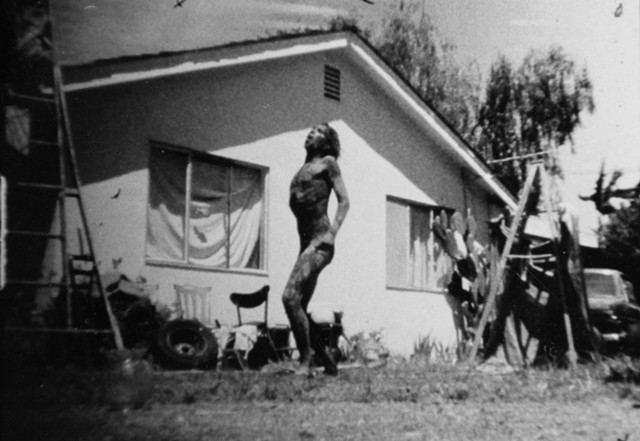Works on FILM
ART OF THE MOMENT, HERE TO STAY
by Roberta Smith, art critic of the New York Times
(excerpt from article)
Countering video's recent technological advances is a surprising amount of low-tech work with a rough-edge early-70's look. One of the most ambitious low-tech efforts is "Jump Fence," a black-and-white work (shot in film, edited on video) that was written, directed, shot and acted by Alfred Hernandez, a young San Francisco film-video artist. Donning different costumes and masks, Hernandez tells a poetic tale of forest spirits and the youth they threaten and protect. Most of the action takes place in the artist's backyard, moved along by white-on-black title cards reminiscent of silent films and the sounds of "primitive" drums and chants. Also crucial is Hernandez's loose-limbed hip-hop dancing, enhanced by multiple replays. For those familiar with "From the Land of the War Canoes," Edward S. Curtis's 1914 film of a Northwest Coast Indian potlatch ceremony, this could be its offspring.
A film that tracks the emotional journey and healing of a young Chicano man. The youth is troubled, riddled with inner conflicts and a restless body filled with pain. He is doing his best to release himself and integrate this energy within him and the holding patterns of his mind and body which he adopted from his (fenced off, boxed in) environment. It is a symbolic story in the sense of dreams where each character and place and object in the dream reflect the psyche of the dreamer. I wanted to fill the film with the psychological practices that I was learning while telling the story as well of colonization and oppression and internalized oppression. This is a story about a Chicano male body and psyche going through a process that ultimately integrates him with the healing power of nature itself.
This film continues an interest I had of taking a look at the body in the environment while contrasting the natural environment with the man-made modern environment - an environment that evolved from colonial ideas about land and society. This is the first film where I use my own body as a subject for imagery and character as I don several masks and play the main character.
For me, this film was a kind of ritual, a Gestalt therapy where I interact with the forces of oppression within me while taking walks through Golden Gate Park with masks and camera equipment. The filmmaker goes on the same journey as the character of the film in a sense. The filmmaking itself becomes a vehicle for healing.
I was living in the Mission District in San Francisco at the time and I had witnessed several acts of violence in the streets that left me feeling baffled and wanting to understand violence. I decided to look at my own experience with violence and thought I would look at the violence in my own home, a violence that was used as a form of punishment but left me an unresolved tension in my body. I wanted to use this video as a way of forgiving my father by looking at the generational aspect of the use of violence which stemmed perhaps, from the early histories of genocide and slavery and punishment of Native people of the Americas.
I had several motifs in mind during the making of the video, from the use of movement and dance, the house and backyard as a symbol of the self, the large floating baby head that was inspired by Siqueiro's Echo of a Scream, hip-hop music and dance. There is an accidental, if not subconscious reflection on some of the imagery in the Wizard of Oz with the large floating head of the Wizard, the wiry dancing of the scarecrow, the lion man, the pointed head of the rigid tinman (mechanical man, in this case becomes the oppressor who whips at the camera like a machine of violence), there are talking trees and a trip through the forest.
I showed this film to inmates in San Quentin State Prison as part of an art in the prisons program. The person who ran the program said that this was the first time they saw the inmates open up and talk about their own lives. After showing the film, one man asked me, "Did you get the belt too?" I believe that the reason this film was able to bring out this kind of discussion was because the form allowed for a variety of dialogue - from the issues brought up in the story to the craft of the filmmaking to the dream images that inspired memories. I thought that perhaps the men would not feel relaxed to talk about these things if this was a straightforward documentary.
Jump Fence was funded by ITVS and the Corporation of Public Broadcasting and shown on various PBS stations in the United States and was features as part of ITVS's American Independents series.
